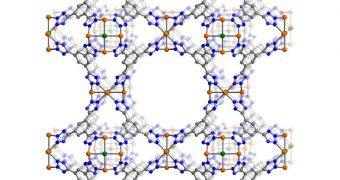A group of investigators is currently working on discovering materials that could be used to readily absorb carbon dioxide. The work is being carried out in order to innovate the carbon capture and storage industry (CCS), which seeks to trap the dangerous greenhouse gas in smokestacks, before it's released into the atmosphere. The team, based at the US Department of Energy's (DOE) Lawrence Berkeley National Laboratory (Berkeley Lab), is conducting its research under the direction of chemist Jeffrey Long, but features researchers from numerous fields. The most promising direction of research is a class of materials called metal-organic frameworks, the team reports.
Getting rid of carbon dioxide is very important, because the gas is mainly responsible for the accelerating global warming our planet is currently experiencing. The chemical also contributes to the acidification of the world's oceans, which harms fish stocks, destroys coral reefs, and threatens marine life supply on which million of people depend for their survival. One of the most promising methods of reducing pollution while keeping costs low is CCS. Though it will most likely be expensive to install the system on existing power plants, scientists say that the companies which will do so will recover their investment over time, if the carbon credit system is introduced.
The Berkeley Lab team is currently trying to discover materials that have the ability to rapidly and efficiently absorb carbon dioxide. Their research target, metal-organic frameworks have impressively-large internal surface areas. One of them, for example, packs the entire surface of a football field inside a volume the size of a sugar cube. Another advantage is the fact that these materials can apparently be tweaked in such a manner that they only become prone to absorbing a certain substance. Researches hope to be able to use this ability to target CO2 directly, by creating sponge-like CCS structures. The team also wants to complete this monumental task in just three years, using advanced robots and investigations methods.
“Our discovery process will be up to 100 times faster than current techniques. We need to quickly find next-generation materials that capture and release carbon without requiring a lot of energy,” Long explains. The proposed automated system will be able to produce and analyze several hundreds of materials at the same time, thus helping scientists eliminate dead times. “We need to find the optimum range of metal-organic frameworks for each power plant. Ultimately, this research is intended to lead to materials worthy of large-scale testing and commercialization. We don’t want to discover a great material and find it’s so expensive that no one will use it,” he concludes.

 14 DAY TRIAL //
14 DAY TRIAL //